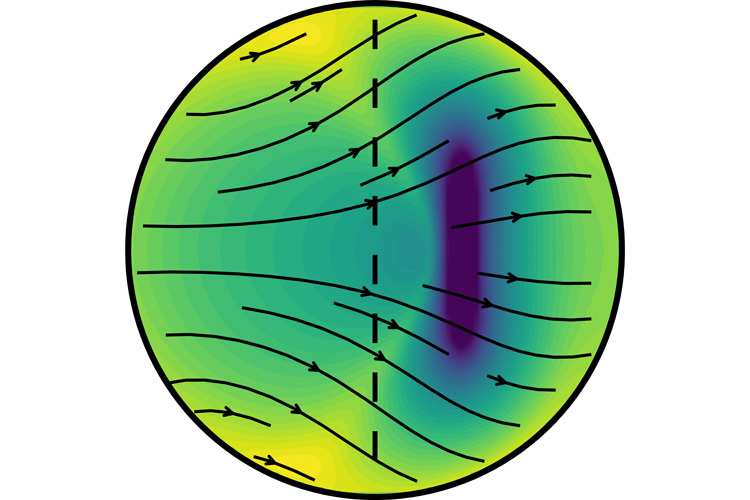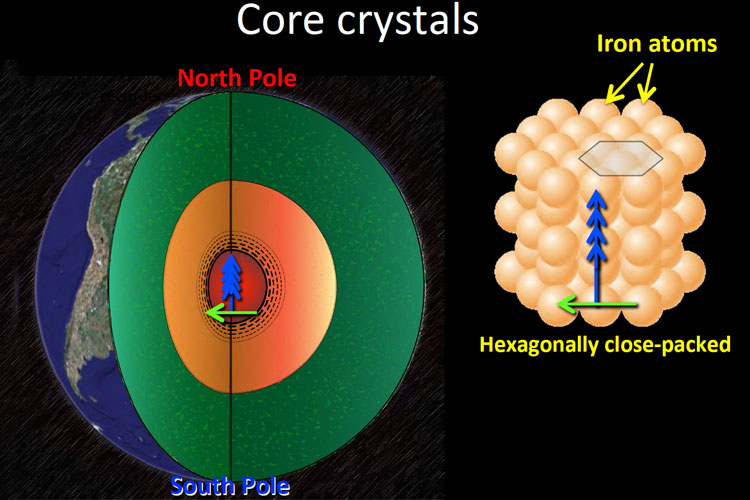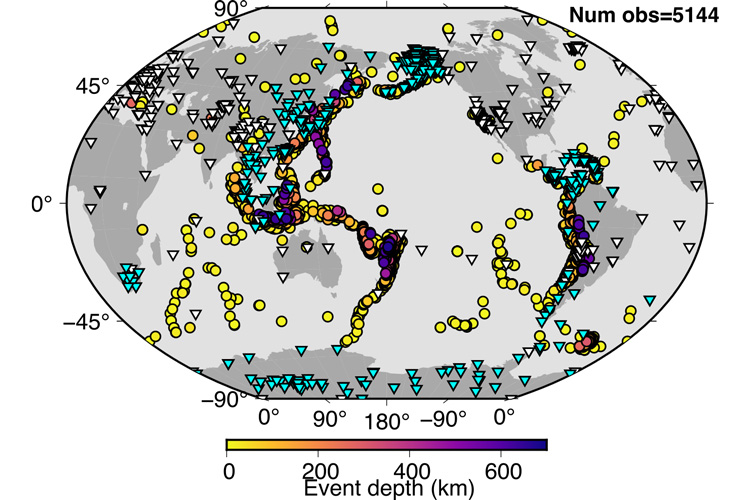Is Earth’s core lopsided? Strange goings-on in our planet’s interior.

For reasons unknown, Earth’s solid-iron inner core is growing faster on one side than the other, and it has been ever since it started to freeze out from molten iron more than half a billion years ago, according to a new study by seismologists at the University of California, Berkeley.
The faster growth under Indonesia’s Banda Sea hasn’t left the core lopsided. Gravity evenly distributes the new growth — iron crystals that form as the molten iron cools — to maintain a spherical inner core that grows in radius by an average of 1 millimeter per year.
But the enhanced growth on one side suggests that something in Earth’s outer core or mantle under Indonesia is removing heat from the inner core at a faster rate than on the opposite side, under Brazil. Quicker cooling on one side would accelerate iron crystallization and inner core growth on that side.
This has implications for Earth’s magnetic field and its history, because convection in the outer core driven by release of heat from the inner core is what today drives the dynamo that generates the magnetic field that protects us from dangerous particles from the sun.
“We provide rather loose bounds on the age of the inner core — between half a billion and 1.5 billion years — that can be of help in the debate about how the magnetic field was generated prior to the existence of the solid inner core,” said Barbara Romanowicz, UC Berkeley Professor of the Graduate School in the Department of Earth and Planetary Science and emeritus director of the Berkeley Seismological Laboratory (BSL). “We know the magnetic field already existed 3 billion years ago, so other processes must have driven convection in the outer core at that time.”
The youngish age of the inner core may mean that, early in Earth’s history, the heat boiling the fluid core came from light elements separating from iron, not from crystallization of iron, which we see today.
“Debate about the age of the inner core has been going on for a long time,” said Daniel Frost, assistant project scientist at the BSL. “The complication is: If the inner core has been able to exist only for 1.5 billion years, based on what we know about how it loses heat and how hot it is, then where did the older magnetic field come from? That is where this idea of dissolved light elements that then freeze out came from.”
Freezing iron
Asymmetric growth of the inner core explains a three-decade-old mystery — that the crystallized iron in the core seems to be preferentially aligned along the rotation axis of the earth, more so in the west than in the east, whereas one would expect the crystals to be randomly oriented.

Evidence for this alignment comes from measurements of the travel time of seismic waves from earthquakes through the inner core. Seismic waves travel faster in the direction of the north-south rotation axis than along the equator, an asymmetry that geologists attribute to iron crystals — which are asymmetric — having their long axes preferentially aligned along Earth’s axis.
If the core is solid crystalline iron, how do the iron crystals get oriented preferentially in one direction?
In an attempt to explain the observations, Frost and colleagues Marine Lasbleis of the Université de Nantes in France and Brian Chandler and Romanowicz of UC Berkeley created a computer model of crystal growth in the inner core that incorporates geodynamic growth models and the mineral physics of iron at high pressure and high temperature.
“The simplest model seemed a bit unusual — that the inner core is asymmetric,” Frost said. “The west side looks different from the east side all the way to the center, not just at the top of the inner core, as some have suggested. The only way we can explain that is by one side growing faster than the other.”
The model describes how asymmetric growth — about 60% higher in the east than the west — can preferentially orient iron crystals along the rotation axis, with more alignment in the west than in the east, and explain the difference in seismic wave velocity across the inner core.
“What we’re proposing in this paper is a model of lopsided solid convection in the inner core that reconciles seismic observations and plausible geodynamic boundary conditions,” Romanowicz said.
Frost, Romanowicz and their colleagues will report their findings in this week’s issue of the journal Nature Geoscience.
Probing Earth’s interior with seismic waves
Earth’s interior is layered like an onion. The solid iron-nickel inner core — today 1,200 kilometers (745 miles) in radius, or about three-quarters the size of the moon — is surrounded by a fluid outer core of molten iron and nickel about 2,400 kilometers (1,500 miles) thick. The outer core is surrounded by a mantle of hot rock 2,900 kilometers (1,800 miles) thick and overlain by a thin, cool, rocky crust at the surface.

Convection occurs both in the outer core, which slowly boils as heat from crystallizing iron comes out of the inner core, and in the mantle, as hotter rock moves upward to carry this heat from the center of the planet to the surface. The vigorous boiling motion in the liquid-iron outer core produces Earth’s magnetic field.
According to Frost’s computer model, which he created with the help of Lasbleis, as iron crystals grow, gravity redistributes the excess growth in the east toward the west within the inner core. That movement of crystals within the rather soft solid of the inner core — which is close to the melting point of iron at these high pressures — aligns the crystal lattice along the rotation axis of Earth to a greater degree in the west than in the east.
The model correctly predicts the researchers’ new observations about seismic wave travel times through the inner core: The anisotropy, or difference in travel times parallel and perpendicular to the rotation axis, increases with depth, and the strongest anisotropy is offset to the west from Earth’s rotation axis by about 400 kilometers (250 miles).
The model of inner core growth also provides limits on the proportion of nickel to iron in the center of the earth, Frost said. His model does not accurately reproduce seismic observations unless nickel makes up between 4% and 8% of the inner core — which is close to the proportion in metallic meteorites that once presumably were the cores of dwarf planets in our solar system. The model also tells geologists how viscous, or fluid, the inner core is.
“We suggest that the viscosity of the inner core is relatively large, an input parameter of importance to geodynamicists studying the dynamo processes in the outer core,” Romanowicz said.
Frost and Romanowicz were supported by grants from the National Science Foundation (EAR-1135452, EAR-1829283).
RELATED INFORMATION
